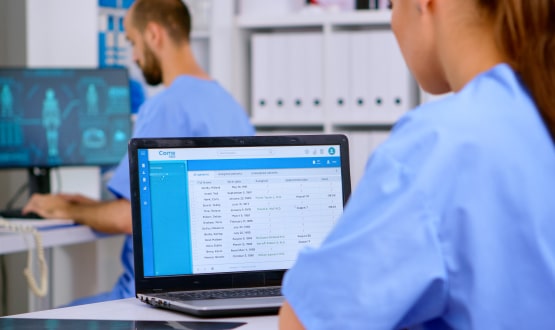Patient feedback can drive positive change, but only if we listen
- 29 March 2022

Fliss Swift, patient experience lead at University Hospitals of Morecambe Bay NHS Foundation Trust (UHMBT), is more passionate than most about gathering patient feedback. And with the NHS grappling with multiple challenges resulting from the Covid-19 pandemic, she believes that more people should recognise its benefits.
I have been lucky enough to work for the NHS for 27 years, with most of these in a patient experience capacity, and so it is fair to say I know the value that patient feedback can provide. For me, it is important to recognise that a patient’s healthcare experience can be influenced by far more than just the diagnosis. After all, many people visiting hospitals are on a healthcare journey, particularly in the current climate with people living longer, and often with co-morbidities. To put this into perspective, they could be experiencing a health crisis due to a serious diagnosis, or it could be the first of many hospital admissions. And here lies the value of patient feedback: as a means of seeing things from a patients perspective and ensuring that we provide the best possible care. Often, it’s small changes that can make a difference.
Changing care pathways
Over the past two years in particular, the NHS has had to adapt. Digital consultations and remote monitoring have increased, inpatient visiting has been restricted and some patients have waited longer than usual for treatment. In times of change, it is crucial to ensure communication between service providers and patients is effective, and that patients, along with their families and carers, are given the opportunity to provide feedback.
It was revealed in a recent Healthcare Communications whitepaper that 48% of people prefer digital communication with their healthcare providers, and that 71% of patients were satisfied with their digital consultation. Given that 89% of trusts introduced digital appointment services because of Covid-19, and that NHS England is prioritising ‘digital first’ approaches across the NHS, these statistics will be reassuring to many. But when it comes to patient feedback, a trust should not rest on its laurels — it should be looking at data and patient feedback on a routine basis, particularly given the volatile nature of patient satisfaction levels across the health and care estate.
But, it’s not just patient satisfaction that we need to be concerned with. There are issues around safety when transitioning to a new channel. For example, if a patient is having a telephone or virtual consultation, instead of face to face, we need to feel assured that each patient is still getting the right level of care, the communication is clear, messages are being understood and there is no detriment to the consultation being undertaken in this way. We have a duty to follow up and check on their experience, but it’s more than that – did they get all the information they required, do they know what is happening next, do they know who and how to contact if their condition changes or they need further support. We have used follow up surveys as a way of checking in with the patient and assuring ourselves that the alternative consultation is fit for purpose. But not all trusts do this. According to YouGov data, only 14% of people who had a remote consultation had been asked for feedback.
Patient feedback offers many benefits
When staff are under pressure, like we know they currently are, there is the tendency to push collection and analysis of Friend and Family Test (FFT) data and other feedback to the bottom of the priority list. This is understandable, as patient care should always come first. But this does not detract from its value, and I would urge trusts to take five minutes to look at feedback themes which, if they have a digital FFT platform such as Healthcare Communication’s Envoy Messenger, is easily accessible and visible on the software dashboard.
Sentiment analysis is also useful in high-traffic areas such as Emergency Departments. I recommend looking at negative comments first to address concerns before they escalate into a more serious issue or formal complaint. I also urge teams to go back to look at the positive comments, even as infrequently as once a month or quarter, and to share positive feedback with staff. Appreciation goes a long way and can often result in improved patient experience because of the boost to morale. This helps with job satisfaction levels, which can lead to better staff retention – again, something that is vital given that many trusts have a high number of vacancies.
A motivator for change
At UHMBT, we collect feedback via voice messages in addition to SMS and online. Hearing a patient say how grateful they are is very powerful, and we play some of the positive feedback at staff meetings because it encourages good practice. I have also played less positive feedback at board meetings, which has led to some real tumbleweed moments when a patient is sharing their frustrations about the care they have received. It can be uncomfortable to listen to, but it is a fantastic motivator for change. Whether it is a serious complaint or something small, all feedback can collectively make a significant difference to patient experience. For example, we had comments about bins clanging at night, so we arranged for soft close lids. This can make a real difference to the quality of sleep a patient has and thus their recovery.
Listening and hearing patients
On the theme of feedback, one area in the patient experience cycle that can often be overlooked is the importance of sharing actions that have been taken following feedback. This helps to demonstrate to patients that we are listening and hearing what they are telling us, which in turn can act to encourage more people to respond to survey requests.
We use patient experience posters, we have a dedicated ‘You Say, We Did’ website, and we publish what we have done on Twitter and other channels to give the public assurances that we are acting on feedback. We also use Healthcare Communications platform to send bulk messages to everyone that provides feedback on a particular issue, thanking them and letting them know what solution the trust has found. In encouraging more people to engage and comment on the services they have received, we are increasing our learning about what good care is from a patient’s perspective which, ultimately, improves the quality of care for everyone.
Patient feedback is such a powerful tool for positive change. It is relatively simple to gather and doesn’t require extensive analysis in order to uncover ways to improve the services we deliver. But it only works if we look at the feedback, listen and action what we have learnt – take a look at the feedback your trust has received and see the difference you can make.




